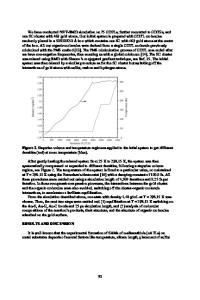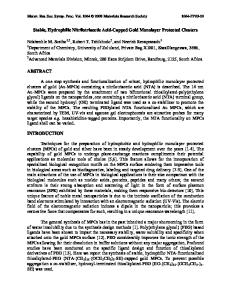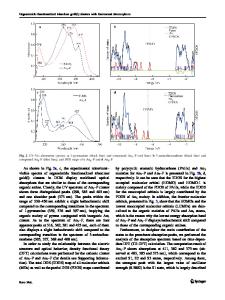HREM of Gold Clusters on MgO Smoke Particles
- PDF / 4,165,386 Bytes
- 6 Pages / 417.6 x 639 pts Page_size
- 67 Downloads / 270 Views
HREM OF GOLD CLUSTERS ON MgO SMOKE PARTICLES P.M AJAYAN and L.D MARKS Department of Materials Science and Engineering NORTHWESTERN UNIVERSITY, EVANSTON, IL 60208 ABSTRACT We present here experimental results using High Resolution Electron Microscopy (HREM), of the structure and behavior of gold clusters on magnesium oxide smoke particles. These indicate that there is a strong interaction between the particle and the s.hstrate, and under electron beam irradiation the particle can Immerse completely into the substrate. Vatious other observations, for instance, motion of twin boundaries, volume shrinkage and surface diffusion, faceting etc., confirm the basic structural instability of small particles. Initial results also indicate that the stability of the cluster depends on particle size, the irradiation flux and the nature of the substrate. INTRODUCTION There has been extensive research, both theoretical and experimental, on the structure and stability of small particles. Recent studies indicate that stable structures at small sizes correspond to icosahedrons, dodecahedrons and multiply twinned particles [1-4], and can fluctuate between various shapes (5-72 .:ndergoirg a phase change to a 'quasi-molten' state [8]. In most of the experimental work the substrates used to support the particles have been weakly-interacting (eg. amorphous carbon) in order to avoid the effect of the substrate on the particle
structure. Theoretical studies on the equilibrium shapes of particles have also generally avoided the influence of the substrates and the energies of interface. But in most practical systems, as in heterogeneous catalysts; the support forms an integral part of the system and the interactions are unavoidable. Systems such as Pt/TiO , which show strong metal substrate interaction (SMS ) (9-i] have received substantial attention in recent years. Some earlier works [12-142 on the equilibrium shapes of small particles using Curie-Wulff construction have addressed the effect of the substrate and the wetting properties of the system as the particle-substrate interaction is changed. But these studies were qualitative and lacked experimental support. We present here a system which could be a model system for strong substrate-particle interactions. The structure of small gold clusters sitting on MgO smoke particles is studied using high resolution electron microscopy (HREM) from the point of view of structural stability and wetting. Initial results from a study of flux dependence on the structure of a small particle are also presented. EXPERIMENTAL METHOD The metal clusters were prepared as explained elsewhere r15,16]. The HgO smoke particles were produced by burning magnesium ribbon in air and collecting on to a copper grid placed above. The clusters were dispersed on the smoke particles by placing a few drops of the cluster solution and letting them dry. Mat. Res. Soc. Symp. Proc. Vol. 139.
1989 Materials Research Society
334
A typical electron microscope image of the distribution of gold particles on the low energy (100
Data Loading...











